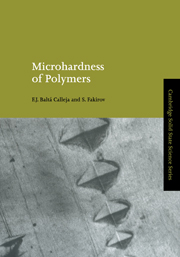Book contents
- Frontmatter
- Contents
- Preface
- Chapter 1 Introduction
- Chapter 2 Microhardness determination in polymeric materials
- Chapter 3 Microhardness of glassy polymers
- Chapter 4 Microhardness of crystalline polymers
- Chapter 5 Microhardness of polymer blends, copolymers and composites
- Chapter 6 Microhardness of polymers under strain
- Chapter 7 Application of microhardness techniques to the characterization of polymer materials
- Author Index
- Subject Index
Chapter 4 - Microhardness of crystalline polymers
Published online by Cambridge University Press: 23 October 2009
- Frontmatter
- Contents
- Preface
- Chapter 1 Introduction
- Chapter 2 Microhardness determination in polymeric materials
- Chapter 3 Microhardness of glassy polymers
- Chapter 4 Microhardness of crystalline polymers
- Chapter 5 Microhardness of polymer blends, copolymers and composites
- Chapter 6 Microhardness of polymers under strain
- Chapter 7 Application of microhardness techniques to the characterization of polymer materials
- Author Index
- Subject Index
Summary
Introduction to crystalline polymers
Polymer crystallization
Under special conditions, amorphous polymers may partially crystallize and become semicrystalline materials. The coexistence of crystalline and amorphous regions is observed in most synthetic polymers that are not obtained by polymerization in the solid state of crystalline monomers or cyclic oligomers. The amorphous state is often called the liquid state, although it may differ quite appreciably from a normal low-molecular-weight liquid. The dominance of the long, randomly coiled, linear macromolecules with the enormous anisotropy of their force field and the presence of crystals strongly affect the behaviour of the chains in the amorphous component. Virtually all amorphous chain sections have one end (cilia) or both ends (folds, tie molecules connecting two different crystals) fixed in the crystal lattice. Hence, the properties of the polymer chains in the surface layer between the crystals and the amorphous layers are substantially different from those in truly amorphous materials without any crystals. Chains of flexible polymers crystallize if they are sufficiently regular and not too hampered in the liquid state by entanglements. Thus a regular, polydisperse, medium-molecular-weight (< 100,000), highly regular PE, without side chains, crystallizes very easily.
In a phase transformation such as crystallization, the two basic processes are the initiation or nucleation process by which a new phase is initiated within a parent phase, and the subsequent growth of the new phase at the expense of the previous one (Gedde, 1995).
- Type
- Chapter
- Information
- Microhardness of Polymers , pp. 80 - 126Publisher: Cambridge University PressPrint publication year: 2000
- 5
- Cited by



